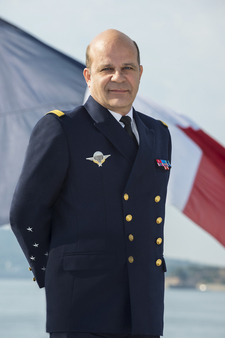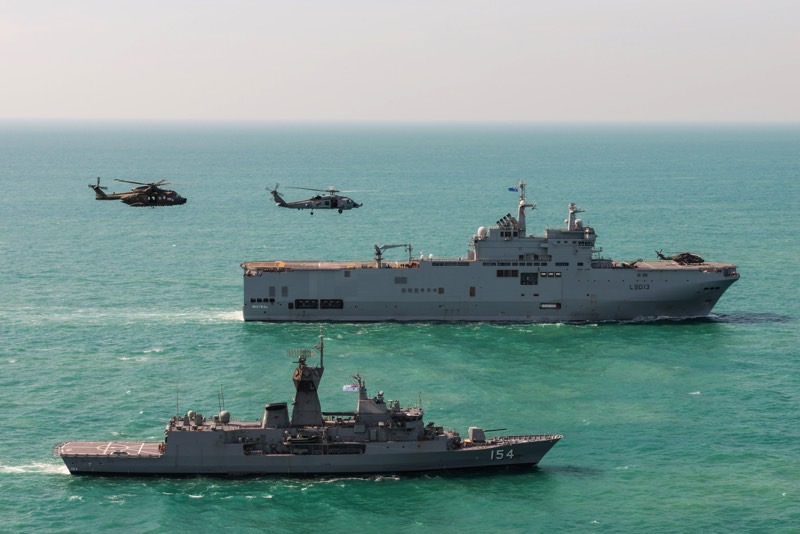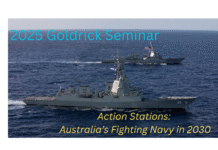
Introduction
With the forthcoming opening of the Sir John Monash Centre in northern France next week by Prime Minister Malcolm Turnbull, and the second visit to Australia of a French President, Emmanuel Macron, in early May, Nicole Forrest Green* speaks with France’s Chief of Navy, Admiral Christophe Prazuck in Paris.
On April 26, 2016 the Australian Prime Minister, the Hon. Malcolm Turnbull MP announced that a multi-billion Australian Defence contract to design the Royal Australian Navy’s next generation of submarines, was awarded to France’s Naval Group (formerly DCNS) subject to further discussions on commercial matters. The Future Submarine program (SEA1000) is the largest and most complex defence acquisition Australia has ever made; this A$50 billion investment will directly sustain around 1,100 Australian jobs and a further 1,700 Australian jobs through the supply chain.
Interview
1). Admiral Prazuck, thank you for taking the time to speak with me today on behalf of the Australian Naval Institute. The ANI’s Patron is Australia’s Chief of Navy, Vice Admiral Tim Barrett AO, CSC, RAN.France is an advanced industrial nation and the custodian of sovereign technological know-how and expertise in a vital strategic sector. To what extent does Australia’s submarine program signify a new era in the AUS-FR relationship and what benefits are likely to accrue to Australia in both the defence and civilian sectors?
Our relationship has grown from strength to strength for a long time, from the battlefields of Flanders and the Somme to the signing in 2009 of our strategic partnership. Furthermore, our sailors know well that we are good neighbours through our custodianship across maritime borders, where we exercise jointly our common rights and duties over vast portions of the Indian and Pacific oceans in an environment and context of mutual respect, professionalism and shared values around the rules based global order that defines engagement at sea. However, I believe that you are absolutely right in that this massive contract announced by Prime Minister Turnbull in April 2016 the largest ever Australia has awarded to a French defence company, represents a turning point in the relationship. In other words, that translates into trust, commitment, long term partnerships and engagement for the decades ahead, to which the French Navy is obviously pivotal.
I am also very proud of France’s national, sovereign shipbuilding industry. While I am not necessarily the best person to comment on specific industrial benefits, (I will leave that to our industrialist) I can attest to the fact that the reinforcement of a nation’s maritime security has far-reaching consequences for economic prosperity, which benefits all sectors of activity.
2). Strengthening Australia’s sovereign defence capability through the development of a regionally superior Navy and future submarine deterrent is fundamental to the strategic needs of our country as an Island continent straddling the Indo-Pacific region. France also has traditionally been a strong advocate of the safeguard of its strategic independence, a corner stone of General de Gaulle’s policies both in and out of public life, particularly in the key areas of defence and energy. An ally of Australia’s in two World Wars and a strategic defence partner, how do you feel France can help Australia enhance its strengths and capabilities across these sectors?
France’s strategic independence has two important legacies in the maritime domain, which I am confident will benefit Australia:
– An independent nuclear deterrent has led us to develop a world-class submarine (and underwater systems’) industry
–
– I also believe that our “independent and unique” foreign policy, strengthens our voice, an example being the way we exercise our freedom of navigation rights in disputed areas.

Recently, France’s new polar vessel the Astrolabe (which bears the same name incidentally as one of two vessels of the original Lapérouse Expedition), left Tasmania for an inaugural voyage to the Antarctic. It will be based in Hobart for half of the year, making it the only French naval vessel stationed outside French territory. This speaks volumes about the commitment, unity and closeness of our naval relationship.
Beyond this symbolism, our navies cooperate regularly and often, in both the Indian and Pacific oceans. We conduct humanitarian assistance and disaster relief operations together such as in Vanuatu and the Kiribati Islands in 2015 following the devastation caused by tropical cyclone Pam. We have worked together in the fight against illegal trafficking, of many kinds – drugs, hijacking, piracy, slavery, (human trafficking) and combat sea-based terrorism, in the Northern Indian Ocean under the auspices of Combined Task Force 150 (CTF-150) a multinational naval task force, working under a 25-nation strong coalition of combined maritime forces.
In 2016, HMAS Darwin and FS Nivose, operated side by side for a month, monitoring, boarding, inspecting and stopping suspect shipping, which resulted in 4 massive drugs seizures that impounded more than 1 ton of heroin.
Further south, our fishery controllers regularly embark on each other’s frigates to patrol our Exclusive Economic Zones (EEZ’s) off the Kerguelen Islands and the territory of Heard Island and the McDonald Islands (HIMI) in the southern Indian Ocean.
Australia and France share the same values and challenges, and as such it makes perfect sense to join forces and work together.
4). Would you tell us about the modernization program begun by your predecessor Admiral Rogel and how the French Navy is adapting to pressure from the Government to find cost savings, while preparing for the future? Operationally, how effective is the new class of B2M multi-purpose supply vessel such as the d’Entrecasteaux based in New Caledonia, what improvements will the FREMM class of frigates and FTI mid-sized frigates enjoy, and what advantages does the Barracuda class of nuclear attack submarines (SSN) provide the service? Are you comfortable with the French Navy’s dissuasive submarine capability (SSBN) and confident they are always at the forefront of global performance?
The French navy embarked on an ambitious modernization program that began in 2005, and which will see 15 new frigates and destroyers commissioned and entering into service before 2030. We are half way through this program, with 3 FREMM and 5 FTI yet to be built.
Of note also, all of our carrier-based multi-role fighters have been French Rafale aircraft since July 2016 (when the last of the Super-E class were decommissioned); our Rubis-class attack submarines (SSN’s) will be replaced by 6 Barracuda-class SSN’s between 2019 and 2029 while our ATL2 MPA fleet (Atlantic-2 Maritime Patrol Aircraft) will be upgraded with modern sensory suites and combat systems.
Am I satisfied that the French Navy’s SSBN (ballistic missile submarines) are at the forefront of global performance? You might very well say that, I couldn’t possibly comment..!
What I would like to emphasize is that since January 1972, France’s nuclear deterrent posture has been uninterrupted, and I trust that the Australian Navy will now witness first-hand, the world-class standard and quality of French underwater systems.
In fact Thales Underwater Systems has just been awarded the contract to develop a new interceptor sonar which will include the latest generation of adaptive antenna processing, classification of algorithms, combined with an innovative bow antenna concept, for the next generation of SNLE’s (SSBN) to be built for the French Navy at Cherbourg.
At the other end of the capability spectrum, our long-overdue replacement program for overseas patrol vessels has finally begun. The last B2M will be delivered this year to the island of Martinique while the third PLG light patrol vessel has just been ordered. The B2M is a fantastically versatile vessel. They have had considerable operational successes already, notably in New Caledonia against “blue boats” pillaging our seabed; named as such, as they are mostly painted sea-blue, carry no electronics and are very difficult to detect as they conduct illegal, unregulated fishing across much of the central Pacific.
5). In Australia recruiting, training and remuneration of crew particularly for submarine service has been challenging. Specialized crews are a great strength to a service but with more automation there is likely to be a reduction in overall crew numbers. France has very contemporary experience of this characteristic manpower conflict in operating increasingly technologically sophisticated platforms from our FREMM program. Would you comment on this and also on the overall percentage of women serving in the French Navy (around 13%) and the consideration being given to allow women to serve on submarines, one of the few areas across French defence that still eludes them?
Being a sailor is a wonderful, yet incredibly demanding job. You risk your life, you go to sea for months, you need to be extremely qualified and at the same time sleep on a 30”cm wide berth with no internet.
Recruitment is not the biggest challenge in France. With the right amount of communication, there is actually a satisfactory supply of young, keen future sailors. However 10-15 years down the line, when they have learnt a difficult job, when they have a family and young children, retention is the real test. We need to constantly review the work package and conditions offered to naval personnel. Salaries are only one aspect. I believe also that wide-spectrum measures are not enough either. We need to make targeted efforts in a number of areas particularly supplements for sea pay, and specialization skills and ability. We also need to make a family’s life easier: accommodation, moving, and childcare. Our nearly 14% of women bear the brunt of these challenges when they raise children and this is why we need to be innovative in the way we attract and remunerate young parents providing for example an “operational pause” rather than losing qualified staff forever. And by the way, we now have our first four women serving on board French submarines.
6). Would you tell us about the longstanding working relationship between Naval Group and Thales Underwater Systems France across the French Navy where significant efficiencies have been realized, continuity and reliability maintained, and where investment in research and development has resulted in improvements and constant upgrades in technological and operational capabilities? Why do you feel this combination Naval Group-Thales France works well?
I mentioned earlier France’s independent nuclear deterrent. I think it is the primary reason why our naval industry is so effective. In Cherbourg, we’ve built one submarine a year for over a hundred years. (The first US submarine, the USS Alligator (1862) it is worth noting, was a French design). Beyond submarines, this categorical imperative for strategic autonomy has far-reaching consequences in many other areas of our naval industry across aircraft carriers, combat systems, missiles, sonars, radar and satellite communication. There is a very efficient cross-pollination between these companies and the end user that will potentially put him or herself in harm’s way in the use of their equipment.
7). I understand that you studied in Monterey California at the US Naval Postgraduate School, obtaining a PHD in oceanographic physics. The AUS-US partnership is a very important one for our nation particularly across defence. How has your time in the United States of America enhanced your understanding of the Pacific region and how do you view the FR-AUS-US partnership working collaboratively in our region in the future?
There hasn’t been a single day in recent years where the U.S. and French naval units haven’t operated side by side in many parts of the globe. Traditionally, two theatres of operation have been at the forefront of U.S-FR naval cooperation: the North Atlantic region since the Cold War and the Northern Indian Ocean since the Tanker War (1984-88). In these theatres, NATO C2 and procedures have always been the bedrock of our interoperability. With over 16 years of joint counter-terrorist operations in the Northern Indian Ocean, these procedures have steadily been shared with other close partners, notably Australian and New-Zealand ships, resulting in all but seamless operational capability today. With French naval patrols in the Pacific becoming a more frequent occurrence, our strategic partnership becoming closer, with areas of cooperation moving towards more high-end areas, I can see the same phenomenon replicating itself in the Asia-Pacific region.
8). Historically, Rear-Admiral Jean-Francois de Galaup, comte de Lapérouse arrived in Australia on 26th January 1788 and set up camp for six weeks on the northern headland of Botany Bay. Prior to his arrival he had seen much of the Pacific including Easter Island, Monterey in California, Cavite in the Philippines, Portuguese Macao, Samoa and Petropavlovsk on the Kamchatka peninsula, Russia. Last year Australia’s Chief of Navy VADM Barrett AO CSC RAN visited the Lapérouse Museum in Sydney for a special AUS-FR-US event and in his speech remarked on the beginnings of the AUS-FR maritime relationship dating back to the earliest days of European settlement in our country. Do you see areas where the Royal Australian Navy and the French Navy can work more closely and directly together including across education and training, military secondments, personnel exchanges, infrastructure and logistical support, strategic dialogues and enhanced naval exercises?
Australia’s European beginnings in 1788 indeed include a French component. The French naval explorers that came to Australia in the 18th and 19th centuries were remarkable navigators even by today’s standards. Lapérouse, d’Entrecasteaux, Baudin and de Freycinet were resilient and courageous, and whose mapping, botanical and scientific work conducted and recorded in service to their country, was impressive; their legacies still bind France and Australia today.
In modern times, and in the context of close cooperation, there are only two naval-exchange Officers servicing currently in a posting to my office in France – the first is Australian, and the second British; I can’t highlight enough the importance and closeness of our relationship. However, we can certainly widen the breadth of our cooperation across multiple areas which is under close consideration and investigation by our various liaison teams through the year, and reviewed at 4* level annually. Yes, there will be much more FR-AUS naval cooperation next year as compared with the current level and where I have it a priority to keep this momentum going for many years into the future.
9). Australia due to its history and regional ties, has tended to work closely with Britain and the United States of America. What would you say to our Anglo-Saxon traditionalists and what benefits do you feel Australia gains when it works with France, in the context of the safeguard of our national security and regional sovereignty? Would you provide examples of where Australia, France and the United States have combined their efforts to work towards common goals and defined benefits?
Well there are a number of expressions I believe that refer to the relationships between family, friends, and neighbours. One such expression looks at the advantage of being able to choose one’s friends freely compared to one’s neighbours and family members. These later two categories (family and community) remain and are a given no matter what happens, reflecting Australia’s history, language and its regional location, signifying bonds that are strong and constructive; France and Australia though are also united by history, common values and a shared perspective, where sovereign independence is an important objective.
Our cooperation in the combined maritime forces (CMF) area has been reaping concrete benefits for over 15 years: vast quantities of drugs such as heroin, thousands of illicit weapons, and billions of dollars’ worth of illegal merchandise have been removed from circulation as a result of our efforts from the hands of terrorist networks, pirates and unscrupulous traffickers.
In the Middle East, ISIS as a pseudo-state and a military entity has been all but eradicated thanks to the combined efforts of many allies, particularly the U.S, including Australian and French naval and air force personnel.
Modern crises have become nomadic; nobody knows how and where the next war will be or be fought. It is very plausible that it could start at sea. It is even more likely to involve a complex web of allies and partners, ruthless violence combined with extremely sophisticated technology. But one thing is certain – it will be won, like the First World War (which marks 100 years since its end this year) by the tighter, more interoperable, more integrated alliance.
Photographs courtesy of the French Embassy, Canberra.
* Nicole Forrest Green is President of the Lapérouse Education Fund, an annual STEM scholarship project that offers young Australian students study opportunities in France with pathways to careers in the Defence industry.




Excellently researched and thorough, and a good understanding of both sides of the relationship. I found it an interesting read and very informative. Also well done with growing the France/Australia scholarship which was Nicole’s initiative and supported by a broad group which is and will generate great benefit for both young Australians and the links between two countries.
Well done Nicole, a thoroughly interesting read.
Australia’s aims of developing full Sovereign defence capability are certainly shared by France. This strategic partnership supported by Prime Minister Turnbull, introduces ‘a third way’ quite a part from the usual, traditional Anglo Saxon cooperation. All that encourages innovation, independence, strength and growth in our region is a step forward. A well written article/interview and nice to see intelligent women across important defence subjects including STEM education.